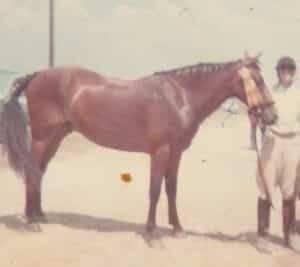 In the summer of 1969, as a horse-crazy 16-year-old girl, I participated in my first hunter/jumper horseshow. It was a blur of sights, sounds and smells, featuring sweaty horses and riders – and I thought I had found nirvana.
In the summer of 1969, as a horse-crazy 16-year-old girl, I participated in my first hunter/jumper horseshow. It was a blur of sights, sounds and smells, featuring sweaty horses and riders – and I thought I had found nirvana.
Generous stablemates had loaned me kit so I looked like a Franken-rider, patched together with bits and pieces, most of them too large and well-worn. My feet were wrapped in towels to stop the loaner-boots from falling off; the hard hat was stuffed with paper to keep it from drooping down to my nose.
My horse, Skipper, lacking the pedigree and stature of the tall, sleek Thoroughbreds, had never been intended for this kind of show ring.
The only ribbon we took home that day? A third place for Hunter Conformation, based on Skipper’s body type and condition.
“A fluke,” I thought, “Or the result of an unaccountably sympathetic judge.”
I did not receive a ribbon in the Hunt Seat Equitation class, which judged the riders’ abilities.
Fast forward 6 months to a different show with a different outcome.
Yes, by then I was kitted out with well-fitting gear of my own, and yes, Skipper and I had trained for an additional half-year.
But what made the difference between the 2 events was not the shiny new kit or even the additional months of training.
It was something so small, it could be easily overlooked.
Right before going into the ring for the Junior Hunt Seat Equitation Class, I noticed one of my stable mates speaking with our riding coach.
As I watched, he gave her a few last-minute pointers on how to do well in the ring.
She trotted off to line up for the class, and I nudged Skipper over to the now-open spot beside our coach.
I asked , “Do you have any tips for me?”
Here’s where this gets really interesting.
Nothing he said was new, or even remarkable. Instead, he reminded me of what I already knew: Heels down, wrists loose but not floppy, back straight.
Skipper and I moved away to join the line entering the ring.
The event took on a time-out-of-time quality. Skipper was amazing and we worked together seamlessly. I knew “it felt good,” but until the end, had no idea just how good.
The judge dismissed everyone not taking a ribbon in the class…and Skipper and I remained in the ring. – with the more expensive horses and experienced (and well-funded) riders.
As ribbons were awarded to each rider, starting with sixth place, that rider would leave the ring. Until at last, there were just two of us remaining, the other rider who had asked for coaching from our teacher, and me.
I thought, “How cool! We got 2nd place!”
Turns out, we took first instead.
This former Franken-rider, come lately to the sport on a horse never meant to be a hunter/jumper, floated out of the ring clutching a blue ribbon and engraved silver cup.
You can argue the new gear boosted my confidence and the additional months of training helped develop skills.
But over half a century later, I recognize something far more significant:
- Co-regulation was at work, supporting me with being my best in that show ring. The regulated nervous system of my riding coach (his calm, clear way of being present) helped regulate my nervous system, moving me past my show ring jitters.
- This in turn supported my brain/body connection so my focus and muscle memory could work together optimally.
- My regulated nervous system translated to my horse, helping him feel calm and collected, so he was not distracted by the other horses, the crowd or the announcer’s voice booming over the speakers.
- I experienced what I think of as a “state” shift – when brain function and biochemistry shift, allowing more effective focus and functioning…all because of a brief conversational interaction.
Yes, it was lovely to go home and surprise my parents with a trophy.
But more impactful, I believe, was the embodied experience of dropping into myself fully in the moment in ways that changed not just that competition but became an internal touchstone and a new benchmark for self-possession.
What I could allow as being possible for me expanded that day in ways surpassing the impact of family, fortune, and even hard work.
It had everything to do with self-connection born of nervous system function and the resulting lived experience.
Why this matters today:
Clients often tell me how much better they feel as we wrap up a coaching session. Neuroscience is showing us why this is:
We now have a much better understanding of co-regulation (what I experienced with my riding coach just before I entered the show ring), and the role it plays, for coaches and their clients, for parents and children, and leaders and their teams in organizations.
Studying with Judith Glaser (Conversational Intelligence, C-IQ) showed me the power of conversation to shift brain chemistry – and therefore, brain state, emotions, perceptions, behaviors.
Her quote sums it all up: Conversation is about more than the exchange of information.
As a 16-year-old underdog at a horse show, I learned conversation, even a brief exchange, can change more than outcomes.
It can change people and their lives, and through that, the world.
Conversations – the kinds of conversations that help us calm chronically over-taxed nervous systems and shift brain chemistry – these are the conversations we need for co-generating entirely new possibilities, including those possibilities we can’t yet imagine.
** * ** * ** * ** *
A final note on boosting performance for ambitious achievers and eager teenage equestriennes:
In that long-ago equitation competition, the 2 riders who took top honors were the ones who had the advantage of last-minute coaching offering grounding in what they knew and that all-important nervous system regulation.

Franken-rider and Skipper, our first show, 1969.
I don’t think that was a coincidence.
When you’re ready to experience the kinds of conversations that help transform people and organizations, here’s how I can help
- The Pit Stop for Busy Women Leaders is a group coaching experience for women seeking more than a time-out on the highway of life; it is a place to calm your nervous system and build new capacities leading to greater self possession. All of this occurs in a container of deep, rich conversations and spot-coaching, with other busy women like you who recognize the power of community to help build the lived experience of personal power. Let’s chat to see if a Pit Stop Group is right for you at this time.
- How to Say the Tough Stuff With Grace – opens for registration shorty. This program resulted from clients asking me questions, almost daily, on how to boost personal effectiveness in challenging situations. Stay tuned for the announcement, shortly on how to reclaim time and bandwidth being lost to difficult interactions, whether prepping for them, avoiding them, or cleaning up after they don’t go well.
- This program is also available in a shortened form for association and organizational meetings, as well as a longer form for cohorts inside your organization. Contact me to discuss.
- If your learning style works best with 1:1 interactions and you’d like to explore whether working with me would support you, let’s talk.

